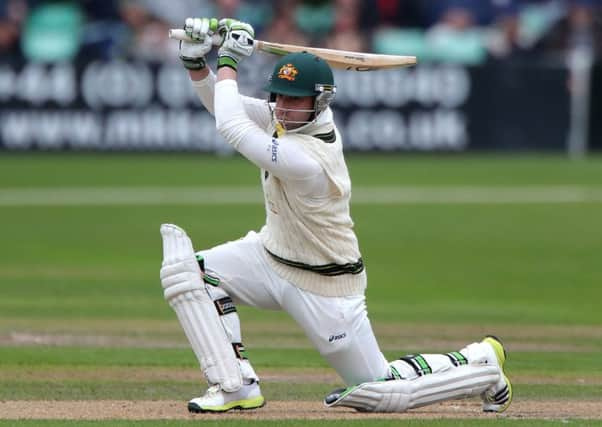Time for reflection after game suffers its saddest day


It is shocking for several reasons.
First, Hughes was a Test cricketer. As such, he was equipped in terms of bravery and skill to deal with the bouncer that claimed his life.
Hughes was no club player, no weekend wannabe with limited talent and lousy equipment, a man who was there just to make up the numbers. This was a man who had played 26 Tests, a man who had become the youngest to score a century in each innings of a Test against South Africa at Durban in 2009.
He was used to the peril of the firing line.
Advertisement
Hide AdAdvertisement
Hide AdSecond, the unfortunate bowler, Sean Abbott, is quick but not devastatingly so.
The 22-year-old New South Welshman is fast-medium as opposed to fast, operating in the region of 80-85mph.
Abbott is no Mitchell Johnson, no Dennis Lillee, no Jeff Thomson, no Michael Holding, no Malcolm Marshall, all of whom touched speeds of 90mph-plus.
In the long and terrifying history of genuine fast bowling, incorporating such tumultuous times as Bodyline in the Thirties and the brutal West Indian pace artillery of the Eighties, Abbott does not come high in the terrifying stakes.
Advertisement
Hide AdAdvertisement
Hide AdThird, Hughes was wearing a helmet, the supposed safeguard against all woes.
In fact, the ball missed his helmet and struck him just below it on the side of the neck around the base of the skull, causing a fatal haemorrhage in his brain.
Safety campaigners will bang their drums – “Helmets aren’t safe enough”, “Helmets aren’t big enough”, “Ban the bouncer”, and so on.
But this was a tragic accident; there have only been 100 cases of Hughes’s condition – “a subarachnoid haemorrhage” – ever reported, and only one as the result of a cricket ball.
Advertisement
Hide AdAdvertisement
Hide AdFourth, Hughes was playing at the Sydney Cricket Ground, a Test match venue, not on a wretched pitch in a minor club game.
The SCG has one of the best pitches in the world – one lovingly tendered and carefully prepared; there are no dangerous deviations of pace and bounce.
Back in the day, cricket was played on some dreadful pitches; in the 19th century, for example, the ball often reared up in frightening fashion and protective headgear was a distant concept.
Today, the pitches worldwide have never been so good, nor batsmen so well-protected from serious harm – a far cry even from the Seventies, when a helmet-less Brian Close (recalled to the England team at 45) courageously ducked and dodged the missiles of Holding.
Advertisement
Hide AdAdvertisement
Hide AdFifth, Hughes was only the second man to die after being hit about the head in a first-class match.
The first, George Summers, perished after being struck by a ball from pace bowler John Platts while batting for Nottinghamshire against MCC at Lord’s in 1870, a game in which WG Grace played for MCC.
Summers – who, like Hughes, was days short of his 26th birthday – was fit enough to return to Nottingham by train only to die from his injuries a short time later. The ball that felled him rose steeply and may have hit a pebble, causing death by brain concussion.
Last, but not least, Hughes’s death is shocking because it proves that such tragedies can happen anywhere to anyone at any time – even a Test player wearing protection.
Advertisement
Hide AdAdvertisement
Hide AdThey could happen regardless of a batsman’s talent or the standard of cricket.
Deaths in club cricket are not totally unusual, where talent and pitches are more variable, but are still highly infrequent.
That a Test player could die proves that no one is safe and reminds us that cricket – like most sports – is fundamentally dangerous.
It seems vaguely trite to say that cricket will never be the same following the dreadful events of 10,000 miles away, but how can it be?
Advertisement
Hide AdAdvertisement
Hide AdLife moves on at blistering pace, yet for all that cricket is a global game, the cricketing family is relatively small.
Like so many overseas players, Hughes is well-known in these parts, having played for Middlesex, Worcestershire and Hampshire, and the sense of loss will be felt in St John’s Wood as it will in South Australia, for whom Hughes played state cricket.
The show will go on – it always does – but how will any bowler feel in the immediate aftermath of Hughes’s death about delivering bouncers?
One can only guess how poor Abbott feels; even if he plays again, he will carry to his grave a life sentence, although anyone who knows anything about the game knows that short balls are part of it and that Hughes’s death was not his fault.
Advertisement
Hide AdAdvertisement
Hide AdOf Platts, who took to slow bowling following Summers’s death, WG Grace wrote: “I shall never forget his mental distraction”.
Abbott needs all the support he can get.
For now, the cry should not be for better helmets and improved safety standards, for standards have never been better.
Rather, it should be for cricket – and those who play it – to look within and vow to improve standards of conduct and sportsmanship on the field, with so many bouncers these days followed up by snarling verbal volleys of personal abuse directed at batsmen, antics that seem utterly redundant now.
Who this morning would bowl a bouncer and follow it up with foul-mouthed threats to hurt and harm?
Hughes’s death puts things into stark perspective.